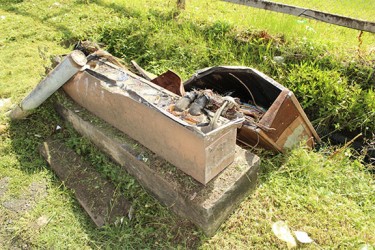Since the beginning of 2015 the Guyana Telephone and Telegraph Company (GT&T) has recorded more than 33 instances of disruption to its line plant associated with vandalism and indiscriminate digging by entities undertaking other works in the vicinity of its cables.
Setting aside what, until now, have been restoration costs in excess of $4 million GT&T says it is equally concerned that the disruptions have resulted in loss of service for varying periods of time to more than 4,000 customers, a circumstance which company spokespersons say has its own implications for public perceptions of the quality of the customer service which GT&T offers.
The data on disruptions shared with Stabroek Business recently suggests that while the periodicity of the disruptions may have been limited to two or three over a fortnight during the earlier period of this year, the past few weeks – particularly the month of March – saw a worrying spike in the number of incidents. There have been few days during the month that has just ended when the company’s line plant has not suffered mostly vandalism-related damage.

Late in February almost 2,000 subscribers suffered temporary loss of service on account of serious vandalizing of cable at Golden Grove on the East Bank Demerara. A further 475 customers suffered a similar fate on March 11 on account of vandalized cable on the New Hope Public Road.
GT&T may not have given up on stemming the flow of costly damage to its installations and mutilation and theft of its prohibitively expensive insulated copper cable though there are clear indications that the company has come to terms with the reality that it simply cannot effectively police its own vast infrastructure. It is a matter of pressing its own security resources into service whilst relying on the Guyana Police Force and the public. And whilst the company does not say so it is difficult to be persuaded that rolling back the incidence of theft and vandalism directed at GT&T is close to the top of the priority list of the police.
More than that the company appears unable to publicly pronounce with any degree of certainty on the extent to which the motive of the vandalism which it suffers might be a function of sabotage rather than cable theft. What it concedes, however, is that, perhaps, a greater measure of civic-mindedness on the part of the public might not only help to check the extent of the vandalism but also increase the rate of apprehension of the culprits.
The instances of arrests and prosecution have been far from sufficient to deter the vandals. More than that, while the theft of metals from GT&T and other utility companies had triggered discourses between the telecoms service provider and local scrap metal dealers and the subsequent reading of an official riot act which had had the effect of significantly shrinking the overseas metal trade, the problem still persists. With the imposition of restrictions on the legitimate export of scrap metals some dealers are believed to have gotten around the problem of metal exports through illegal trans-border arrangements involving foreign middle men.
GT&T, meanwhile, appears to be gearing itself for another surge in the incidence of vandalism, a not uncommon phenomenon in a practice which the company has had to endure for years.
No less frustrating for the company GT&T spokespersons told Stabroek Business, is the fact that much of its loss of service has been due to indiscriminate digging by private and public sector contractors resulting in the breaking of underground cables and attendant loss of service. GT&T says its concern over the non-vandalism aspect of its line plant disruption has to do with the fact that while the transgressors are aware of the protocols associated with digging at locations where GT&T infrastructure is installed, there have been cases, apparently many, in which the offending entities simply do not bother themselves to follow those protocols. More than that, it would appear that not all of the offenders have been compliant in reimbursing the company for the damage and there are instances in which it has had to pursue litigation.
The company says it remains open to reviewing and where necessary, upgrading the protocols associated with works of a different nature being undertaken at sites where the integrity of GT&T cables might be threatened though it insists that even now damage due to indiscriminate digging can be minimised if the prevailing protocols are followed. The theft and vandalising of utility company infrastructure has become a global phenomenon, but this provides GT&T with cold comfort. The company makes the point that the strengthening of the country’s telecommunications infrastructure is critical to its broader developmental aspirations and to the quality of life of Guyanese and that, accordingly, the security of its infrastructure is, as much as anything else, a matter in which the citizens as a whole are a collective stakeholder.




